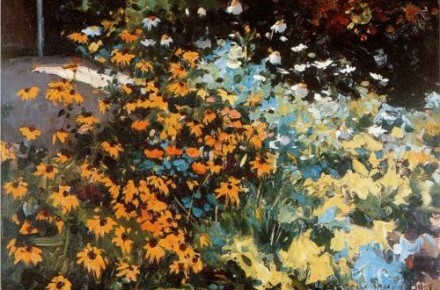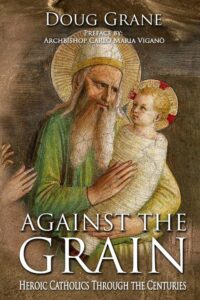With the election season heating up and the usual sins threatening to conquer us, it’s time to talk about… art.
Eve Tushnet makes a penetrating observation* in an upcoming issue of First Things magazine: If you (a sinner) cannot imagine a different way of life, if you do not see virtue as a real and vital possibility, then you cannot experience conversion. And without the conversion of individual souls, there will be no conversion of the culture, no renewed respect for the human person, no communal solidarity or self-sacrifice.
Yet the best method to communicate these needs usually does not lie in philosophy. A person’s openness to logical argument is half-determined before the argument begins. Molding his perception of what is possible and what is desirable is the culture that surrounds him — the paintings, films, poems, photographs, TV shows, books, stories, songs, and plays that have shaped his imagination. If the good and the true do not appear beautiful in these works of art, they will not seem good or true, either.**
In brief, art tends to normalize what it portrays. If in art the human person is degraded, the vulnerable are treated with contempt, and life is chaotic and meaningless, then the viewer may conclude, even if only unconsciously, that the best worldview is “every man for himself.” But if art portrays beauty, order, friendship, and the sacred, honoring the dignity of the individual, then the viewer may look for more in his philosophy.
So how do we cultivate a more beautiful culture? Simple: If you’re an artist, create things of beauty; if you’re not, then go out of your way to find, treasure, and share beautiful things. Here are a few ways to start.
1. Visit museums! So many beautiful pieces of art languish in museums, yearning for visitors. Give them some love. This is easiest, of course, in major metro areas like Washington, D.C., and New York City, but many colleges have small art museums. Get a list of museums by state here. (Granted, museums don’t always do much for contemporary artists, but they do foster an appreciation for art.)
2. Attend concerts, plays, movies, recitations of poetry, and other cultural events. Sure, it’s possible to rent movies, to listen to CDs, to read poetry online, but beauty is best experienced in the flesh. This is harder to do if you’re not in a major metro area, but colleges, high schools, and community groups still put out some beautiful work.
3. Buy books, artwork, photography, magazines, CDs, etc. Free access to art (via the Internet) is awesome, but in the long run, there will be little new art if no one is willing to pay the artist. So, where to find contemporary art, music, and texts worth paying for…
Artists: I’m partial to Michael O’Brien (though his work is out of my price range), Matthew Alderman (website, flickr), and Daniel Mitsui.
Writers: I’ve listed some great Catholic novels here before. My favorite contemporary writers are probably Marilynne Robinson, Wendell Berry, Mark Helprin, and Michael O’Brien (the artist who also writes).
Poets: Dana Gioia, Wendell Berry (the novelist/essayist also writes poetry), A.M. Juster, Brian Doyle, and Sally Thomas (yes, this Sally Thomas) have all written some lovely poetry. A fellow Hillsdale alum has praised some other poets that I’m not yet familiar with — Averill Curdy, A. E. Stallings, Steve Gehrke, and Roddy Lumsden — for defying today’s “poetry-about-poetry house-of-cards garbage.”
Publishing houses: Ignatius Press may take the top spot; also keep an eye on Our Sunday Visitor, St. Augustine’s Press, Franciscan Media (includes Servant Books, St. Anthony Messenger Press), and the Sophia Institute Press.
Magazines: Naturally I must recommend my current employer, First Things (essays and poetry). Via St. Peter’s List, you can find fiction, art, poetry, essays, and more in Image, Dappled Things, and Pilgrim. I’ve also enjoyed The Christendom Review.
Movie studios/directors/films: You can’t go wrong with Grassroots Films. Icon Productions is behind a few good movies of recent years. I am dreadfully ignorant about film, though. Who else is good?
Musicians: My ignorance of movies is only outweighed by my ignorance of contemporary bands and musicians, so you’ll have to help me out here. I like Scythian, for one. Conductor and composer Richard Proulx, who died in 2010, put out some wonderful sacred music in recent years.
So, what great artists or promoters of art did I miss? Share in the comments!
Further reading:
Pope John Paul II’s Letter to Artists
Pope Benedict’s Address to Artists
*Eve Tushnet makes this point in a totally different context, namely that of Catholic sexual morality, but I wanted to credit her for the basic insight.
**I haven’t distinguished here between Catholic/Christian art and secular art, though my specific recommendations emphasize the former. Some secular art better communicates Christian truths (that life is sacred, etc.) better than some Christian art does, though obviously that’s not to say that there’s no need for explicitly Christian art. But this point, the related exploration of didactic art’s many pitfalls, the question of portraying vs. glamorizing sin, and many other related issues are beyond the scope of this post. The image is “Flower Beauty” by Cornelis Vreedenburgh, via Wikipaintings.






11 thoughts on “Cultivating Beauty”
Pingback: Archbishop Cordileone DUI St. Augustine Confessions IVF iPad | Big Pulpit
Hey, Anna!
Thanks for the mention. It’s great to find that the Hillsdale community goes on. Also, while not specifically Catholic or concerning art, Front Porch Republic is an excellent inspiration for thoughtful living in the modern age.
Serena
You’re welcome! I saw the poetry-related post and some others from your and Betsy’s blog on Facebook, and I’ve been enjoying them. I do like FPR as well — mainly I want to sit around with the contributors, drinking and arguing, which is basically a good measure of thoughtful living, right? 🙂
Sr. Paula Beierschmitt of the American Academy of Sacred Arts in Philadelphia. http://aasacredarts.com/sacredart.html
______
Henry Wingate in Virginia. http://www.henrywingate.com
______
Don Gianluca Busi in Bologna, Italy. http://ilsegnodigiona.it/
Thanks for this, Anna! Beauty touches the heart, and our heart is what God wants most.
Also important, as I’m learning very painfully: be beautiful!
This is a helpful post for homeschoolers + all parents; thanks for listing. Jeff Ostrowski is writing sacred music for Mass at his Watershed project { not sure how to post a link } maybe someone help?
A belated thanks to all of you for your tips! In case anyone’s still following this comment thread, I just wanted to add one last resource: the International Arts Movement, a movement “dedicated to inspiring all people to engage their culture to create a more good and beautiful world.” I’m pretty sure their founder — an artist named Makoto Fujimura — makes an appearance in the movie “The Human Experience,” incidentally.
Thank you for writing this. I am a young Catholic artist, I’m beginning to delve into making sacred art. I have some projects in initial stages up on my blog if you want to check them out:
http://john1v14.blogspot.com/
I’m currently living in the Bronx serving with LAMP Ministries, though I plan on leaving toward the end of September. If you want to meet up while I’m here or just otherwise be in touch, don’t hesitate to contact me at ShanaSmith89 (at) gmail.com. I’m always looking to connect with those who share my mission for revealing God through beauty. God bless you and keep up the good writing.
Shana – You’re welcome, I enjoyed checking out your blog! I would be happy to meet up if possible. I know of a group of Catholic artists here in New York that’s having a special Mass said for them later this month… I’ll email you with details!
thanks this
Pingback: Fifty Essential Religious Songs » First Thoughts | A First Things Blog